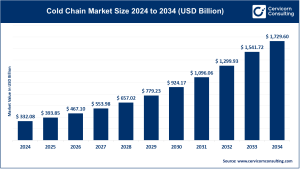1. Market Overview
The electric vehicle battery market is witnessing strong momentum as global EV uptake accelerates and supportive government policies continue to strengthen. In 2024, the market size stood at USD 79.64 billion, and it is forecasted to surge to USD 679.80 billion by 2034, reflecting a robust 23.91% CAGR throughout 2025–2034.
The Asia-Pacific region remains the industry frontrunner, capturing 50.8% of total revenue in 2024. This leadership is fueled by well-established battery production hubs and a mature EV ecosystem across major markets such as China, Japan, and South Korea.
From a technology standpoint, lithium-ion batteries dominate with 64.93% market share, while Hybrid Electric Vehicles (HEVs) account for 34.8% of demand. The pouch cell design leads battery formats with 43.09% share, and batteries within the 50–110 kWh capacity range represent the largest segment at 32.31%. Among materials, lithium continues to be the most widely used, comprising 34.45% of the market.
Get a Free Sample:
https://www.cervicornconsulting.com/sample/2370
2. Key Market Trends
1. Breakthroughs in Solid-State Battery Development
The market is gradually shifting toward solid-state battery technologies, which offer enhanced safety, greater energy density, and longer operational life. Companies across the value chain are heavily investing in research and commercialization efforts to bring these advanced batteries to market over the coming decade.
2. Growth of Ultra-Fast Charging Systems
Cutting-edge ultra-fast charging solutions are dramatically reducing charging time, helping overcome range-related concerns and improving the practicality of EV ownership. This trend is particularly influencing adoption in high-mileage segments such as commercial transport.
3. Accelerated Battery Recycling & Second-Life Applications
Recycling activities are expanding to reclaim critical materials like lithium, nickel, and cobalt. In parallel, end-of-life EV batteries are being repurposed into energy storage systems, contributing to a circular economy and reducing the environmental impact of battery waste.
4. Rising Integration of Vehicle-to-Grid (V2G) Capabilities
With V2G technology, EVs can supply electricity back to power grids, enhancing grid flexibility, supporting renewable energy, and offering additional revenue potential for vehicle owners and fleet operators.
5. Growth in Battery Leasing and Subscription Programs
Leasing models are making EV ownership more accessible by lowering upfront costs. They also provide consumers with the flexibility to switch to newer battery technologies as they become available.
6. Expansion of Global Gigafactories
Manufacturers are continuously scaling operations by setting up gigafactories around the world. These large-capacity facilities strengthen production networks, optimize costs, and reduce supply chain vulnerabilities.
3. Market Drivers
1. Increasing Shift Toward Electric Mobility
Growing environmental awareness, concerns over fuel costs, and an expanding preference for sustainable transportation are pushing EV sales upward, consequently driving battery demand.
2. Government Incentives & Policy Interventions
Governments are introducing stricter emission standards, tax incentives, and domestic manufacturing programs. For instance, India has eliminated customs duties on key battery components to boost local production and reduce costs.
3. Continuous Advancements in Battery Technology
Ongoing innovations—including solid-state battery R&D, improved cathode and anode materials, and high-density cell designs—are enhancing safety, range, and affordability, accelerating EV adoption globally.
4. Increasing Consumption of Critical Battery Materials
In 2023 alone, global battery production required roughly 140,000 tons of lithium, 150,000 tons of cobalt, and 370,000 tons of nickel. This rising demand is prompting more investment in mineral sourcing, strategic partnerships, and recycling.
5. Expansion of Circular Economy Approaches
As recycling and second-life solutions become more economically viable, they are reducing reliance on raw materials and creating new commercial opportunities in energy storage.
6. Strengthening Partnerships Across the Supply Chain
Collaborations among automakers, technology companies, and battery producers are becoming essential to innovate faster, secure supply chains, and scale manufacturing more efficiently.
4. Impact of Trends and Drivers
Impact on Battery Types & Technologies
-
Lithium-ion batteries will maintain dominance in the near term.
-
Solid-state batteries are expected to disrupt the market in the medium to long run.
-
Higher-capacity battery packs are gaining importance as demand for long-range EVs grows.
Impact on Regional Dynamics
-
The Asia-Pacific region will continue leading the global landscape due to its advanced production capabilities.
-
North America and Europe are accelerating through substantial investments in domestic gigafactories and EV-friendly legislation.
Impact on Applications
-
Passenger cars benefit from ultra-fast charging and improved energy density.
-
Heavy-duty EVs (trucks, buses) increasingly require high-capacity, thermally optimized battery systems.
-
Second-life batteries are bolstering the renewable energy sector through grid-scale storage solutions.
-
V2G features are transforming EVs into distributed energy assets.
5. Challenges & Opportunities
Key Challenges
-
Volatility in raw material availability and pricing
-
High development and production costs for next-generation batteries
-
Technical and economic hurdles in battery recycling
-
Geopolitical risks affecting critical mineral supply chains
Major Opportunities
-
Expansion of recycling infrastructure and technologies
-
Growth in second-life energy storage applications
-
Development of alternative battery chemistries with fewer critical minerals
-
Rapid construction of gigafactories worldwide
-
Adoption of innovative battery ownership models
6. Future Outlook
The EV battery market is poised for transformative growth over the next decade:
-
Market value will climb from USD 79.64 billion in 2024 to USD 679.80 billion by 2034, supported by a strong 23.91% CAGR.
-
Asia-Pacific will continue leading, while North America emerges as a fast-growing hub due to manufacturing expansions and supply chain localization.
-
Solid-state batteries are expected to begin commercial rollout within 5–10 years, reshaping competitive dynamics.
-
Key future trends will include ultra-fast charging, V2G deployment, material recycling, and second-life battery systems.
-
Battery leasing and subscription models will likely become mainstream, particularly among cost-conscious buyers.
For comprehensive insights:
To Get Detailed Overview, Contact Us:
https://www.cervicornconsulting.com/contact-us
